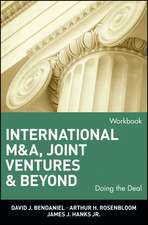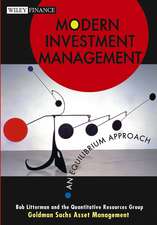Modern Banking: The Wiley Finance Series
Autor S Heffernanen Limba Engleză Paperback – 25 noi 2004
Din seria The Wiley Finance Series
- 20%
 Preț: 444.01 lei
Preț: 444.01 lei - 20%
 Preț: 432.77 lei
Preț: 432.77 lei - 20%
 Preț: 466.32 lei
Preț: 466.32 lei - 20%
 Preț: 508.37 lei
Preț: 508.37 lei - 20%
 Preț: 474.95 lei
Preț: 474.95 lei -
 Preț: 340.84 lei
Preț: 340.84 lei - 20%
 Preț: 384.23 lei
Preț: 384.23 lei -
 Preț: 344.21 lei
Preț: 344.21 lei - 8%
 Preț: 489.15 lei
Preț: 489.15 lei -
 Preț: 427.39 lei
Preț: 427.39 lei - 24%
 Preț: 573.27 lei
Preț: 573.27 lei - 20%
 Preț: 515.22 lei
Preț: 515.22 lei - 20%
 Preț: 507.62 lei
Preț: 507.62 lei - 20%
 Preț: 443.14 lei
Preț: 443.14 lei -
 Preț: 220.23 lei
Preț: 220.23 lei - 8%
 Preț: 340.90 lei
Preț: 340.90 lei -
 Preț: 432.04 lei
Preț: 432.04 lei -
 Preț: 274.90 lei
Preț: 274.90 lei - 20%
 Preț: 440.31 lei
Preț: 440.31 lei - 8%
 Preț: 532.04 lei
Preț: 532.04 lei - 8%
 Preț: 381.87 lei
Preț: 381.87 lei -
 Preț: 441.70 lei
Preț: 441.70 lei - 20%
 Preț: 429.01 lei
Preț: 429.01 lei -
 Preț: 444.58 lei
Preț: 444.58 lei -
 Preț: 195.81 lei
Preț: 195.81 lei -
 Preț: 363.83 lei
Preț: 363.83 lei - 20%
 Preț: 476.30 lei
Preț: 476.30 lei - 20%
 Preț: 429.66 lei
Preț: 429.66 lei - 24%
 Preț: 682.97 lei
Preț: 682.97 lei - 20%
 Preț: 482.01 lei
Preț: 482.01 lei - 20%
 Preț: 488.31 lei
Preț: 488.31 lei - 9%
 Preț: 1075.80 lei
Preț: 1075.80 lei - 9%
 Preț: 969.57 lei
Preț: 969.57 lei - 9%
 Preț: 745.28 lei
Preț: 745.28 lei - 8%
 Preț: 555.63 lei
Preț: 555.63 lei - 9%
 Preț: 767.24 lei
Preț: 767.24 lei - 8%
 Preț: 632.63 lei
Preț: 632.63 lei - 9%
 Preț: 789.52 lei
Preț: 789.52 lei - 9%
 Preț: 807.09 lei
Preț: 807.09 lei - 9%
 Preț: 706.01 lei
Preț: 706.01 lei - 8%
 Preț: 553.17 lei
Preț: 553.17 lei - 8%
 Preț: 615.85 lei
Preț: 615.85 lei - 9%
 Preț: 719.75 lei
Preț: 719.75 lei - 9%
 Preț: 888.44 lei
Preț: 888.44 lei - 9%
 Preț: 755.88 lei
Preț: 755.88 lei - 8%
 Preț: 708.98 lei
Preț: 708.98 lei - 9%
 Preț: 835.76 lei
Preț: 835.76 lei - 9%
 Preț: 961.77 lei
Preț: 961.77 lei - 9%
 Preț: 778.17 lei
Preț: 778.17 lei - 9%
 Preț: 954.94 lei
Preț: 954.94 lei
Preț: 535.15 lei
Preț vechi: 695.01 lei
-23% Nou
Puncte Express: 803
Preț estimativ în valută:
102.40€ • 107.49$ • 84.99£
102.40€ • 107.49$ • 84.99£
Carte tipărită la comandă
Livrare economică 10-24 aprilie
Preluare comenzi: 021 569.72.76
Specificații
ISBN-13: 9780470095003
ISBN-10: 0470095008
Pagini: 736
Dimensiuni: 189 x 235 x 39 mm
Greutate: 1.48 kg
Editura: Wiley
Seria The Wiley Finance Series
Locul publicării:Chichester, United Kingdom
ISBN-10: 0470095008
Pagini: 736
Dimensiuni: 189 x 235 x 39 mm
Greutate: 1.48 kg
Editura: Wiley
Seria The Wiley Finance Series
Locul publicării:Chichester, United Kingdom
Public țintă
Primarily courses on Financial Markets and Institutions, but also used on modules on Corporate Finance and Investments courses at Undergraduate, MBA and Masters levels.Cuprins
ACKNOWLEDGEMENTS.
PREFACE.
CHAPTER 1: What are Banks and What Do They Do?
1.1 Introduction.
1.2 The Meaning of Banking.
1.3 Organisational Structures.
1.4 Banking Structures.
1.5 Financial Conglomerates.
1.6 Central Banking.
1.7 Summary: Why are Banks Special?
1.8 Conclusion.
CHAPTER 2: Diversification of Banking Activities.
2.1 Introduction.
2.2 The Expansion of Banks into Non-banking Financial Services.
2.3 The Effect of Non-interest Income on Banks' Total Income.
2.4 Global Markets and Centres.
2.5 International Banking.
2.6 Banking Issues in the 21st Century.
2.7 Conclusion.
CHAPTER 3: Management of Risks in Banking.
3.1 Introduction.
3.2 Key Financial Risks in the 21st Century.
3.3 Approaches to the Management of Financial Risks.
3.4 Financial Derivatives and Risk Management.
3.5 Management of Market Risk.
3.6 Management of Credit Risk.
3.7 Risk Management by Major Global Bank.
3.8 Conclusion.
CHAPTER 4: Global Regulation of Banks.
4.1 Introduction.
4.2 Why Regulate?
4.3 International Regulation.
4.4 Basel 2 - The Three Pillar Approach.
4.5 Alternative or Complementary Approaches to Basel.
4.6 International Financial Architecture.
4.7 Conclusion.
CHAPTER 5: Bank Structure and Regulation: UK, USA, Japan, EU.
5.1 Introduction.
5.2 Bank Structure and Regulation in the UK.
5.3 Bank Structure and Regulation in the USA.
5.4 Bank Structure and Regulation in Japan.
5.5 Bank Structure and Regulation in the EU.
5.6 Conclusions: Structure and Regulation of Banks.
CHAPTER 6: Banking in Emerging Economies.
6.1 Introduction.
6.2 Financial Repression and Evolving Financial Systems.
6.3 Banking Reforms in Russia, China and India.
6.4 Islamic Banking.
6.5 Sovereign and Political Risk Analysis.
6.6 Conclusion.
CHAPTER 7: Bank Failures.
7.1 Introduction.
7.2 Bank Failure - Definitions.
7.3 Case Studies on Bank Failure.
7.4 The Determinants of Bank Failure: A Qualitative Review.
7.5 Bank Failure: Quantitative Models.
7.6 Conclusion.
CHAPTER 8: Financial Crises.
8.1 Introduction.
8.2 Definitions and Controversies.
8.3 The South East Asian Financial Crisis, 1997-99.
8.4 The Japanese Banking Crisis.
8.5 Scandinavian Banking Crises.
8.6 Long Term Capital Management (LTCM).
8.7 Lender of Last Resort.
8.8 Conclusions.
Appendix 8.1 Japanese Financial Reforms (Big Bang, 1996).
Appendix 8.2 Reform of the Regulators.
CHAPTER 9: Competitive Issues in Banking.
9.1 Introduction.
9.2 Measuring Bank Output.
9.3 X-efficiency, Scale Economies and Scope Economies.
9.4 Empirical Models of Competition in Banking.
9.5 Consolidation in the Banking Sector.
9.6 Conclusion.
CHAPTER 10: Case Studies.
10.1 Introduction.
10.2 Goldman Sachs.
Appendix.
10.3 Kidder Peabody Group.
10.4 From Sakura to Sumitomo Mitsui Financial Group.
10.5 Bancomer: A Study of an Emerging Market Bank.
10.6 Credit Lyonnais.
10.7 Continental Illinois Bank and Trust Company.
10.8 Bankers Trust: From a Commercial/Investment Bank to Takeover by Deutsche Bank.
REFERENCES/BIBLIOGRAPHY.
INDEX.
Descriere
Looks at the theory and practice of modern banking, and at the prospects for the future. This text is devoted to micro issues of banking, including competition, structure, performance, risk, and regulation.



















